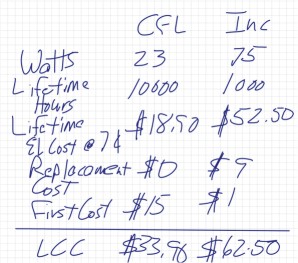
Last week this commentary regarding energy efficiency mandates from the Heritage Foundation showed up in my Google news feed, and it made for an interesting read. I hold the same view when it comes to shoving products down the gullets of people like the goose in preparation of foie gras, a disgusting practice. That is not a way to make friends for desired lasting results. E.g., we’re going to unplug the water cooler to save energy and you will like the warm water. Besides, the feng shui will improve and bring better karma because that cold stuff throws your system out of whack. I would expect responses of “feng shui you!, cheap _____!”
The author, Nicolas Loris (Nick), states the argument for mandates is consumers and businesses reduce energy use, save money, and their kids use 50% less foul language[1]. Nick goes on to say consumers are already incentivized by the free market to conserve, without mandates. This is true but here is the rub: consumers (the masses) are irrational and businesses are considerably more rational, but yet, still plenty irrational.
Let’s talk a smidge about mandates before moving on to decision-making by end users. There are energy efficiency mandates for light bulbs, auto fleets, toilets, refrigerators, air conditioners, and I’m sure there are others that I’m not aware of.
More or Less Equal Mandates
Not all energy efficiency mandates are equal. More equal mandates are better. What are more equal mandates? Ones that do not have any perceptible degradation of performance or a long-term price premium. Which energy efficiency mandates fall into this category? Refrigerators and air conditioners, and for the most part, toilets, although there were problems in the early days- a whole other topic. Cars and light bulbs have clear performance and consumer preference issues. People love their cars, man. Myself included. Don’t screw with my car. [2]
Nick states in his article that Secretary of Energy, Chu, once quipped that energy efficiency mandates are needed because people “aren’t acting in a way that they should act.” There is some red meat for the opposition, but I have to agree that smacks of unplugging the water cooler and telling people it’s for their own good.
Rational Consumers?
Moving on to consumer / end-user choices, Nick says consumers are smart enough to choose for themselves and are doing so. From a mass market perspective, I disagree. Mass market consumers, excluding most people reading this rant, are awfully irrational. Consider the beloved compact fluorescent light bulb, which provides a fascinating case study (hang with me).

Fifteen years ago these things cost over $10 a piece. They didn’t fit fixtures because the ballast (base) was about 3 inches long and the entire light bulb was about 10 inches long just begging to be whacked off, spilling toxic mercury everywhere. Doing a simple life cycle cost analysis (shown to the left) for the 10,000 hour lifetime of a CFL, a consumer would have to be crazy not to buy these and fill their house with these things.
I would claim that since that time energy efficiency programs, not mandates, have driven the technology to vastly improve and the price to plummet to the point where consumers would have to be really, really nuts to not buy CFLs, but for a few fixtures that aren’t used often. The price is now at least 80% lower. The lamps are more efficient and come in colors (temperatures) other than cold mortuary gray.
A mandate is not required or warranted for CFLs. The market has been transformed with relatively great speed. The non-energy impacts are, in some instances, greater than the energy impacts. Speaking for labor and the cost of man-hours to keep replacing bulbs every 1000 hours varies from a nice feature, to a massive advantage, depending on the consumer.
Consumers are still too irrational for the modern CFL in many cases. They need gimmicks and games, trinkets, brownie points. This is what behavioral programs are all about for residential customers.
See a better approach to geese (consumers) – lure and educate them rather than force feeding. These consumers are wary and are probably used to fresh croissants rather than the stale crust this guy is peddling. The screen-left goose is thinking, this guy is a moron. I’m out of here.
I’m running low on space but moving on to commercial and industrial end users, the barriers are much different. They are much more willing to do things that improve their financial situation. In many cases, they don’t know or realize where their cost effective opportunities are, they don’t have the time to deal with it, and in some cases they lack capital or the presentation to the bean counters to convince energy efficiency is a wise investment versus a new lawn mower or snow plow. Mandates are not going to affect these customers, but they really, really need expertise, services, and sound information.





